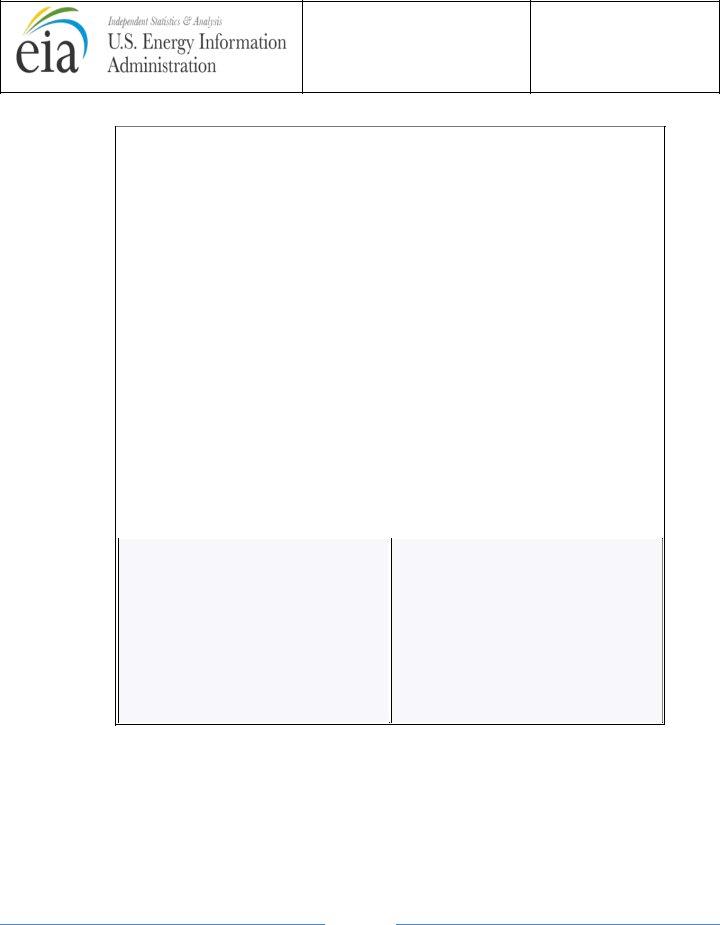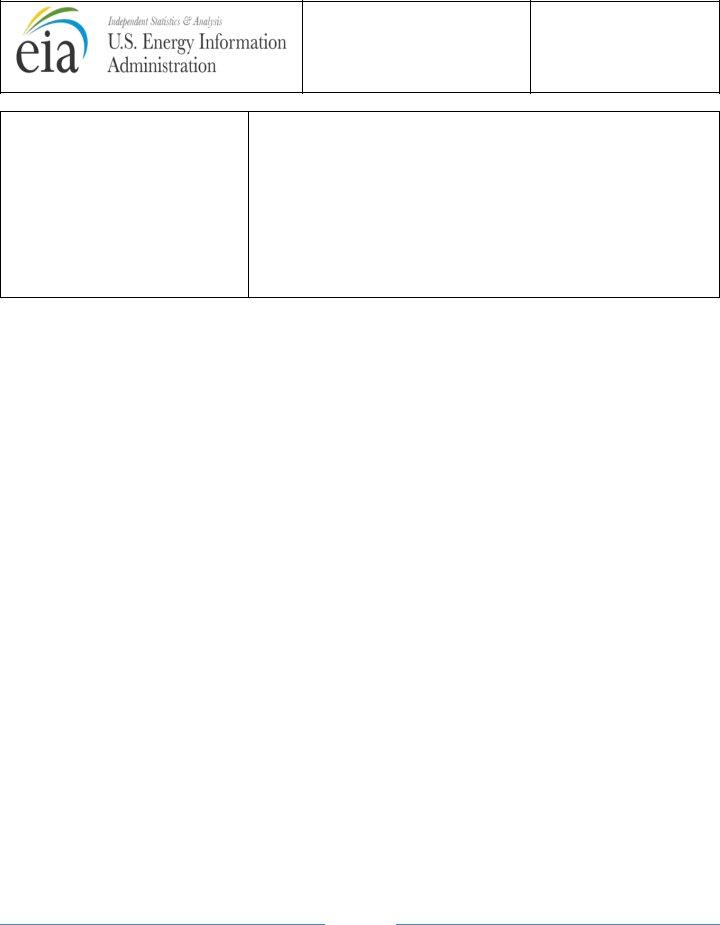The Form EIA-861, known as the Annual Electric Power Industry Report, plays a crucial role in gathering comprehensive data on the electric power industry within the United States and its territories. By collecting information from a wide array of respondents including electric utilities, Demand Side Management Program Managers, wholesale power marketers, energy service providers, and electric power producers, among others, it provides a detailed snapshot of the industry's status, its participants, and trends. The insights derived from the data collected contribute significantly to monitoring and evaluating the industry's current state and its future direction. Furthermore, the form is essential for organizations involved in the generation, transmission, distribution, and sale of electric energy, making its completion a requirement. The form not only facilitates the submission of data electronically via a secure internet data collection system but also mandates a submission deadline by April 30 following the end of the calendar year, emphasizing its critical role in regulatory compliance and industry analysis. With specific instructions for reporting, including the requirement to submit data in whole numbers and the procedure for estimating data when exact figures are unavailable, the Form EIA-861 ensures accuracy and uniformity in the information collected, supporting the formulation of effective energy policies and the development of strategies aimed at addressing the challenges faced by the electric power industry.
| Question | Answer |
|---|---|
| Form Name | Form Eia 861 |
| Form Length | 23 pages |
| Fillable? | No |
| Fillable fields | 0 |
| Avg. time to fill out | 5 min 45 sec |
| Other names | eia 861 annual form, american electric power company emergency form print, eia industry report, eia 861 data |

FORM
ANNUAL ELECTRIC POWER
INDUSTRY REPORT
INSTRUCTIONS
Approval: OMB No.
Approval Expires: 5/31/2023
Burden Hours: 12.75
PURPOSE |
|
|
|
|
Form |
||
|
involved in the generation, transmission, distribution, and sale of electric energy in the |
||
|
United States and its territories. The data from this form are made available in EIA |
||
|
publications and databases. The data collected on this form are used to monitor the |
||
|
current status and trends of the electric power industry and to evaluate the future of the |
||
|
industry. |
||
|
|
||
REQUIRED |
The Form |
||
RESPONDENTS |
limited to, electric utilities, all Demand Side Management (DSM) Program Managers |
||
|
(entities responsible for conducting or administering a DSM program), wholesale power |
||
|
marketers, energy service providers, electric power producers, transmission owners, |
||
|
transmission operators, and Third Party Owners of solar PV (TPO). Responses are |
||
|
collected at the operating company level (not at the holding company level). |
||
|
|
||
RESPONSE DUE |
Submit the completed Form |
||
DATE |
calendar year. |
||
|
|
|
|
METHODS OF FILING |
|
|
|
RESPONSE |
Submit your data electronically using EIA’s secure internet data collection system |
||
|
This system uses security protocols to protect information against unauthorized access |
||
|
during transmission. |
||
|
• If you have not registered with EIA’s Single |
||
|
requesting assistance to the Form |
||
|
• If you have registered with Single |
||
|
https://signon.eia.gov/ssoserver/login |
||
|
Please retain a completed copy of this form for your files. |
||
|
|
||
CONTACTS |
Internet System Questions: For questions related to |
||
|
information immediately above. |
||
|
Data Questions: For questions about the data requested on Form |
||
|
Survey Manager: |
||
|
|
|
David Darling |
|
202 |
||
|
|
Email: David.Darling@eia.gov |
|
|
|
FAX Number: |
|
|
|
Email: |
|
|
|
|
|
|
|
|
|
|
|
PAGE 1 |
|
|
|
|
|

FORM
ANNUAL ELECTRIC POWER
INDUSTRY REPORT
INSTRUCTIONS
Approval: OMB No.
Approval Expires: 5/31/2023
Burden Hours: 12.75
GENERAL INSTRUCTIONS
1.Respondents, who also submit the Form
2.For paper forms only, complete the information at the top portion of the form with the name, telephone and FAX number, and email address of the current contact person and the contact person’s supervisor.
3.Report peak demand in megawatts and energy values (e.g., generation and sales) in megawatthours, except where noted. One megawatthour equals 1,000 kilowatthours. To convert kilowatthours to megawatthours, divide by 1,000 and round to the nearest whole number. For example, sales of 5,245,790 kilowatthours should be reported as 5,246 megawatthours.
4.Report in whole numbers (i.e., no decimal points), except where explicitly instructed to report otherwise. For example: revenue of $8,459,688.42 should be reported as 8,460 (thousand dollars). There is one decimal place in the revenue on Schedules 2C and 4. Lines 2 and 4 on Schedule 6A and lines 3 and 4 on Schedule 6B also contain one decimal point.
5.For the
6.For number of customers, enter the average of the 12
All respondents having
Count each meter as a separate customer in cases where commercial franchises or residential
Please do not count each pole as a separate customer even if billing is by a flat rate per pole per month.
7.Use a minus sign for reporting negative numbers. Line 9 on Schedule 2B must be a negative number. On Schedule 2B, line 1 and Schedule 2C, lines 4 and 6, the number may be either positive or negative.
8.Where exact data are unavailable, report estimated data.
9.See the Glossary for terms used in this survey. The financial and accounting terms are consistent as outlined in the Uniform System of Accounts for Public Utilities and Licensees (U.S. of A.) (18 CFR Part 101).
PAGE 2

FORM
ANNUAL ELECTRIC POWER
INDUSTRY REPORT
INSTRUCTIONS
Approval: OMB No.
Approval Expires: 5/31/2023
Burden Hours: 12.75
Ownership Codes
Municipal Marketing Authority (A): Voted into existence by the residents of a municipality and given authority for creation by the state government. They are nonprofit organizations.
Behind the Meter (B): Entities that install, own, and/or operate a system (usually photovoltaic), and sell, under a long term power purchase agreement (PPA) or lease, all the production from the system to the homeowner or business with which there is a net metering agreement. Third Party Owners (TPOs) of PV solar installations use this ownership code.
Cooperative (C):
Nonutility DSM Administrator (D): Only involved with
Federal (F): Government agencies with the authority to deliver energy to
Municipal (M): Entities that are organized under authority of state statute to provide a public service to residents of that area.
Political Subdivision (P) (also called "public utility district"): Independent of city or county government and voted into existence by a majority of the residents of any given area for the specific purpose of providing utility service to the voters. State laws provide for the formation of such districts.
Independent Power Producer or Qualifying Facility (Q): Entities that own power plants and sell their power into the wholesale market.
Retail Power Marketer (R) or Energy Service Provider: Entities that market power to customers in restructured markets.
State (S): Entities that own or operate facilities or provide a public service.
Transmission (T): Entities that operate or own high voltage transmission wires that provide bulk power services.
Wholesale Power Marketer (W): Entities that buy and sell power in the wholesale market.
SCHEDULE 1: IDENTIFICATION
1.Survey Contact: Verify contact name, title, email address, telephone number, fax number.
2.Supervisor of Contact Person for Survey: Verify the contact’s supervisor’s name, title, address, telephone number, fax number and email address. Supervisor contact must be different than the survey contact.
If any of the above information is incorrect or missing, please send revisions to
PAGE 3

FORM
ANNUAL ELECTRIC POWER
INDUSTRY REPORT
INSTRUCTIONS
Approval: OMB No.
Approval Expires: 5/31/2023
Burden Hours: 12.75
Entity and Preparer Information
3.Legal Name of Entity: Enter the legal name of the entity for which this form is being prepared.
4.Current Address of Entity’s Principal Business Office: Enter the complete address, excluding the legal name, of the entity’s principal business office (i.e., headquarters, main office, etc.).
5.Preparer’s Legal Name: Enter the legal name of the company that prepares this form, if different from the Legal Name of Entity.
6.Current Address of Preparer’s Office: Enter the address to which correspondence regarding this form should be mailed, if different from the Current Address of Entity’s Principal Business Office. Include an attention line, room number, building designation, etc. to facilitate the future handling and processing of the Form
SCHEDULE 2, PART A: GENERAL INFORMATION
1.For line 1, please check all of the Regional Entities within the North American Electric Reliability Corporation (NERC), in which your organization conducts operations.
The Regional Entities are:
TRE (Texas Reliability Entity [ERCOT])
FRCC (Florida Reliability Coordinating Council)
MRO (Midwest Reliability Organization)
NPCC (Northeast Power Coordinating Council)
RFC (ReliabilityFirst Corporation)
SERC (SERC Reliability Corporation)
SPP (Southwest Power Pool, RE)
WECC (Western Electricity Coordinating Council)
2.For line 2, select the RTO or ISO from the list:
California ISO
Electric Reliability Council of Texas
Southwest Power Pool
Midwest ISO
PJM Interconnection
New York ISO
ISO New England
None
3.For line 4, Operate Generating Plant(s), check ‘Yes’ to indicate that your organization operated at least one generating plant during the reporting period. Otherwise, check ‘No.’
4.For line 5, Activities, check the appropriate activities the electric entity was engaged in during the reporting year. If your activity is not listed on line 5, include in Schedule 9. At least one activity must be provided.
PAGE 4

FORM
ANNUAL ELECTRIC POWER
INDUSTRY REPORT
INSTRUCTIONS
Approval: OMB No.
Approval Expires: 5/31/2023
Burden Hours: 12.75
Generation from company owned plant. Owned power generation.
Transmission. Owned or leased transmission lines.
Buying transmission services on other electrical systems. Types of services include borderline customers, transmission line rental, transmission capacity, transmission wheeling, and system operational services.
Distribution using owned/leased electrical wires. Power delivery to your own
Buying distribution on other electrical systems. Types of support include customer billing, distribution system support charges for energy delivered, line maintenance, and/or equipment charges.
Wholesale power marketing. Wholesale transactions with other electric utilities, purchases from power producers, and transactions to export and/or import electricity to or from Canada or Mexico. Also includes electrical sales and purchases among Federal Energy Regulatory Commission (FERC) registered power marketers and similar participation in transactions with electric utilities.
Retail power marketing. Provision of electrical energy to
Combined services. Provision of electricity in combination with gas, water, cable, Internet, and/or telephone for a single price.
5.For line 6, Highest Hourly Electrical Peak System Demand (MW), electric utility companies should enter the maximum hourly summer load (for the months of June through September) based on net energy for the system during the reporting year. Net energy for the system is the sum of energy an electric utility needs to satisfy their service area and includes full and partial wholesale requirements customers, and the losses experienced in delivery. The maximum hourly load is determined by the interval in which the
6.For line 7,
SCHEDULE 2, PART B: ENERGY SOURCES AND DISPOSITION
1.Enter the annual megawatthours (MWH) for all sources of electricity and disposition of electricity listed.
2.For line 1, Net Generation, enter the net generation (gross generation minus station use) from all
PAGE 5

FORM
ANNUAL ELECTRIC POWER
INDUSTRY REPORT
INSTRUCTIONS
Approval: OMB No.
Approval Expires: 5/31/2023
Burden Hours: 12.75
Include generation used to replace system losses arising from wheeling transactions. Include net generation supplied as part of a tolling arrangement.
3.For line 2, Purchases from Electricity Suppliers, enter the total amount of energy purchased from electricity suppliers including: nonutility power producers and power marketers (reported separately in previous years), municipal departments and power agencies, cooperatives,
4.For line 3, Exchanges Received (In), enter the amount of exchange energy received. Do not include power received through tolling arrangements.
5.For line 4, Exchanges Delivered (Out), enter the amount of exchange energy delivered. Do not include power delivered as part of a tolling arrangement.
6.For line 5, Exchanges (Net), enter the net amount of energy exchanged. Net exchange is the difference between the amount of exchange received and the amount of exchange delivered (lines 3 and4). This entry should not include wholesale energy purchased from or sold to regulated companies or unregulated companies for other systems.
7.For line 6, Wheeled Received (In), enter the total amount of energy entering your system from other systems for transmission through your system (wheeling) for delivery to other systems. Do not report as Wheeled Received, energy purchased or exchanged for consumption within your system, which was wheeled to you by others.
8.For line 7, Wheeled Delivered (Out), enter the total amount of energy leaving your system that was transmitted through your system for delivery to other systems. If Wheeling Delivered is not precisely known, please estimate based on your system's known percentage of losses for wheeling transactions.
9.For line 8, Wheeled (Net), enter the difference between the amount of energy entering your system for transmission through your system and the amount of energy leaving your system (line 6 minus line 7). Wheeled net represents the energy losses on your system associated with the wheeling of energy for other systems.
10.For line 9, Transmission by Others, Losses, enter the amount of energy losses associated with the wheeling of electricity provided to your system by other utilities. Transmission by Others, Losses should always be expressed as a negative value.
11.For line 11, Sales to Ultimate Customers, enter the amount of electricity sold to customers purchasing electricity for their own use and not for resale. This entry should correspond to the revenue from sales to ultimate customers reported on Schedule 2 Part C, line 1, and should be equal to the total megawatthours reported on Schedule 4, Parts A, B and D, when summed for all reported states.
12.For line 12, Sales for Resale, enter the amount of electricity sold for resale purposes. This entry should include sales for resale to power marketers (reported separately in previous years), full and partial requirements customers, firm power customers, and
PAGE 6

FORM
ANNUAL ELECTRIC POWER
INDUSTRY REPORT
INSTRUCTIONS
Approval: OMB No.
Approval Expires: 5/31/2023
Burden Hours: 12.75
identify on Schedule 9, the portion of sales for resale power sold through tolling arrangements and any international sales.
13.For line 13, Energy Furnished without Charge, enter the amount of electricity furnished by the electric utility without charge, such as to a municipality under a franchise agreement or for public street and highway lighting. This entry does not include data entered in line 14.
14.For line 14, Energy Consumed by Respondent without Charge, enter the amount of electricity used by the electric utility in its electric and other departments without charge. This entry does not include data entered in line 13.
15.For line 15, Total Energy Losses, enter the total amount of electricity lost from transmission, distribution, and/or unaccounted for. This is the difference between line 10, "Total Sources," and the sum of lines 11, 12, 13, and 14. Total Energy Losses should always be expressed as a positive value.
SCHEDULE 2, PART C: ELECTRIC OPERATING REVENUE
1.All electric operating revenue data should be rounded to the nearest tenth and reported in thousand dollars; for example, revenue of $8,461,688.42 should be reported as 8,461.7 (thousand dollars).
2.For line 1, Electric Operating Revenue from Sales to Ultimate Customers, enter the amount of revenue from sales of electricity to those customers purchasing electricity for their own use and not for resale. Revenue reported on Schedule 4C, for delivery service (and all other charges) should not be reported on Schedule 2C, line 1, but should be reported in Schedule 2C, line 2, Revenue from Unbundled (Delivery) Customers. Revenue entered on line 1 is gross revenue and includes the revenue from state and local income taxes, energy or demand charges, customer service charges, environmental surcharges, franchise fees, fuel adjustments and other miscellaneous charges applied to
3.For line 2, Revenue from Unbundled (Delivery) Customers, enter the amount of revenue from unbundled customers who purchase their electricity from a supplier other than the electric utility that distributes power to their premises. This electric operating revenue does not include the charges for electric energy but does include the revenue required to cover power delivery. Revenue entered on line 2 should be the same total revenue reported on Schedule 4C, column e, when summed for all states.
4.For line 3, Electric Operating Revenue from Sales for Resale, enter the amount of revenue from sales of electricity sold for resale purposes. This entry should include revenue from sales for resale to wholesale or retail power marketers, full and partial requirements customers (firm), and to no requirements
5.For line 4, Electric Credits/Other Adjustments, enter the amount of deferred revenue, which corresponds to Account 449.1 of the Uniform System of Accounts including revenue not applied to end- use or resale customers during the normal billing cycle. Funds included in this entry consist of refunds to customers resulting from rate commission rulings delayed beyond the reporting year in which the funds were originally collected. Also, include revenue distributions to customers from rate stabilization funds
PAGE 7

FORM
ANNUAL ELECTRIC POWER
INDUSTRY REPORT
INSTRUCTIONS
Approval: OMB No.
Approval Expires: 5/31/2023
Burden Hours: 12.75
where the distribution occurred during the current reporting year but the funds were collected during previous reporting years.
6.For line 5, Revenue from Transmission, enter the amount of revenue derived from the transmission of electricity for others (wheeling).
7.For line 6, Other Electric Operating Revenue, enter the amount of revenue received from electric activities other than selling electricity. This may include revenue from selling or servicing electric appliances, revenue from the sale of water and water power for irrigation, domestic, industrial or hydroelectric operations, revenue from electric plants leased to others, revenue from the sale of steam, but not including sales made by a steam heating department or transfers of steam under joint facility operations, revenue from interdepartmental rents or sale of electric property, revenue from late fees, penalties or reconnections, and revenue from interest.
SCHEDULE 3, Part A: DISTRIBUTION SYSTEM INFORMATION
For purposes of this schedule, a distribution circuit is any circuit with a voltage of 35kV or below that serves end use customers directly or through
Volt/VAR Optimization (VVO) is a process used by electric distribution companies to actively manage voltage levels and reactive power on distribution circuits in order to reduce energy losses and improve reliability and power quality. VVO is typically achieved through the use of
1.On line 1 enter the Total Number of Distribution Circuits.
2.On line 2 enter the Total Number of Distribution Circuits that employ voltage/VAR optimization (VVO).
SCHEDULE 3, Part B: DISTRIBUTION SYSTEM RELIABILITY
INFORMATION - IEEE
If your entity calculates system average interruption duration index (SAIDI) and system average interruption frequency index (SAIFI) and determines Major Event Days in accordance with the IEEE
PAGE 8

FORM
ANNUAL ELECTRIC POWER
INDUSTRY REPORT
INSTRUCTIONS
Approval: OMB No.
Approval Expires: 5/31/2023
Burden Hours: 12.75
subtitle “Excluding Major Events” and do not complete the area under the subtitle “Including Major Events”.
1.The system average interruption frequency index, or SAIFI, indicates how often the average customer experiences a sustained interruption (of over 5 minutes) over a predefined period of time. In this schedule report annual SAIFI, or the SAIFI resulting from all interruptions in the reporting year. SAIFI is calculated as the sum over the year of total number of customers that experienced an interruption of more than 5 minutes, divided by the total number of customers.
2.SAIFI = [Sum of total number of customers interrupted over the year] / [Total number of customers served]
3.The system average interruption duration index, or SAIDI, indicates the total duration of interruption for the average customer over a predefined period of time. In this schedule report annual SAIDI, or the SAIDI resulting from all interruptions in the reporting year. SAIDI is calculated as the sum over the year of all customers interrupted for more than 5 minutes times the number of minutes they experienced an interruption, divided by total number of customers.
4.SAIDI = [Sum of customer minutes interrupted over the year] / [Total number of customers served]
5.On lines 3 through 6 report the values that you calculate.
a.Report the Annual Distribution SAIDI Including Major Event Days on line 3,
b.Report the Annual Distribution SAIDI Excluding Major Event Days on line 3,
c.Report both the Annual Distribution SAIDI Including Major Event Days excluding events where the reliability event was initiated from loss of supply (e.g. resulted from an event on the distribution system, not from the
d.Report the Annual Distribution SAIFI Including Major Event Days on line 5,
e.Report the Annual Distribution SAIFI Excluding t Major Event Days on line 5,
f.Report both the Annual Distribution SAIFI Including and Excluding Major Event Days excluding events where the reliability event was initiated from loss of supply on line 6.
6.On line 7, enter the Total number of customers used to calculate SAIDI and SAIFI, as reported on this schedule. A customer is defined as a metered electrical service point for which an active bill account is established at a specific location (e.g., premise). (IEEE
7.On line 8, indicate the voltage at which you distinguish the distribution system from the supply system.
8.On line 9, indicate whether your company has an outage management system that detects loss of load or customer outages. Answer “yes”, even if you also receive outage information manually via other methods.
SCHEDULE 3, PART C: DISTRIBUTION SYSTEM RELIABILITY
INFORMATION – OTHER
SAIDI and SAIFI calculations via other methods, calculated by state
1.On lines 10 through 11 report the values that you calculate.
PAGE 9

FORM
ANNUAL ELECTRIC POWER
INDUSTRY REPORT
INSTRUCTIONS
Approval: OMB No.
Approval Expires: 5/31/2023
Burden Hours: 12.75
a.Report the Annual Distribution SAIDI Including major events on line 10,
b.Report the Annual Distribution SAIDI Excluding major events on line 10,
c.Report the Annual Distribution SAIFI Including major events on line 11,
d.Report the Annual Distribution SAIFI Excluding major events on line 11.
2.On line 12, enter the total number of customers used to calculate SAIDI and SAIFI, as reported on this schedule.
3.On lines 13, indicate whether your utility includes inactive accounts in its definition of customers used to determine SAIDI and SAIFI.
4.On line 14, indicate how your utility defines momentary outages, i.e., less than how many minutes. Outages can be classified as either momentary or sustained. Momentary outages are not included in determining SAIDI and SAIFI.
5.On line 15, report the voltage that you use to distinguish the distribution system from the supply system.
6.On line 16, indicate whether your company has an outage management system that detects loss of load or customer outages. Answer “yes”, even if you also receive outage information manually via other methods.
SCHEDULE 4, PART A: SALES TO ULTIMATE CUSTOMERS.
FULL SERVICE – ENERGY AND DELIVERY SERVICE (BUNDLED)
The table below should be used as a guide for the classification of your
Enter the reporting year revenue (thousands of dollars, to the nearest tenth), megawatthours, and number of customers for sales of electricity to ultimate customers by state, balancing authority, and customer class category for whom your company provides both energy and delivery service. Power marketers providing both energy and delivery service should report on Part D. Note: For sales to customer groups using brokers or aggregators, continue to count each customer separately. For instance, count a group of franchised commercial establishments aggregated through a single broker as separate customers (as reported in prior years). Using the drop down menus, enter the
PAGE 10

FORM
ANNUAL ELECTRIC POWER
INDUSTRY REPORT
INSTRUCTIONS
Approval: OMB No.
Approval Expires: 5/31/2023
Burden Hours: 12.75
|
The residential sector includes private |
|
The commercial sector includes |
||
|
|
||||
|
households and apartment buildings |
|
nonmanufacturing business |
||
|
where energy is consumed primarily for: |
|
establishments such as: |
||
|
• |
space heating |
|
• |
hotels |
|
• |
water heating |
|
• |
motels, |
|
• |
air conditioning |
|
• |
restaurants |
|
• |
lighting |
|
• |
wholesale businesses |
|
• |
refrigeration |
|
• |
retail stores |
|
• |
cooking |
|
• health, social, and educational |
|
|
• |
clothes drying |
|
|
institutions |
|
|
|
|
• public street and highway |
|
|
|
|
|
|
lighting |
|
|
|
|
• |
municipalities |
|
|
|
|
• divisions or agencies of states |
|
|
|
|
|
|
and federal governments under |
|
|
|
|
|
special contracts or agreements, |
|
|
|
|
|
and other utility departments, as |
|
|
|
|
|
defined by the pertinent |
|
|
|
|
|
regulatory agency and/or electric |
|
|
|
|
|
utility |
|
|
|
|
|
|
|
|
|
|
|
|
The industrial sector includes:
•manufacturing
•construction
•mining
•agriculture (irrigation),
•fishing
•forestry establishments
The transportation sector includes:
•railroads and railways (The fuel source of propulsion must be electrical like a metro system which exists in large cities. Please count number of systems not meters.)
SCHEDULE 4, PART B: SALES TO ULTIMATE CUSTOMERS
PAGE 11

FORM
ANNUAL ELECTRIC POWER
INDUSTRY REPORT
INSTRUCTIONS
Approval: OMB No.
Approval Expires: 5/31/2023
Burden Hours: 12.75
Enter the reporting year revenue (thousands of dollars, to the nearest tenth), megawatthours, and number of customers for sales of electricity to ultimate customers by state, by balancing authority, and customer class category for which your company provides only the energy consumed, where another electric utility provides delivery services, including, for example, billing, administrative support, and line maintenance.
SCHEDULE 4, PART C: SALES TO ULTIMATE CUSTOMERS
Enter the reporting year revenue (thousand dollars, to the nearest tenth), megawatthours delivered, and number of customers for sales of electricity to ultimate customers in your service territory by state by balancing authority and customer class category for which your company provides only billing and related energy delivery services, where another company supplies the energy. Entities completing this Schedule are also required to complete Schedule 6 Part D, Advanced Metering and Customer Communications.
SCHEDULE 4, PART D: SALES TO ULTIMATE CUSTOMERS. BUNDLED SERVICE (ENERGY SERVICE PROVIDERS AND POWER MARKETERS)
Note: typically, the only entities that report on Schedule D are Texas Energy Service Providers. Any other entity that believes it should report on Schedule D should first contact EIA.
Enter the reporting period revenue (thousands of dollars, to the nearest tenth), megawatthours, and number of customers for sales of electricity to ultimate customers by state, by balancing authority, and customer class category for whom your company provided both energy and delivery service. For public street and highway lighting, count all poles in a community as one customer. Note: For sales to customer groups using brokers or aggregators, continue to count each customer separately. For instance, count a group of franchised commercial establishments aggregated through a single broker as separate customers (as reported in prior years). Enter the
Common Instructions: SCHEDULE 4. PARTS A, B, C, AND D
1.For the
2.For column a, Residential, enter the revenue, megawatthours, and number of customers for electric energy supplied for residential (household) purposes. For the residential class, do not duplicate the customer accounts due to multiple metering for special services (e.g., water heating, etc.).
3.For column b, Commercial, enter the revenue, megawatthours, and number of customers for electric energy supplied for commercial purposes.
4.For column c, Industrial, enter the revenue, megawatthours, and number of customers for electric energy supplied for industrial purposes.
5.For column d, Transportation, enter the revenue, megawatthours, and number of customers for electric energy supplied for transportation purposes.
PAGE 12

FORM
ANNUAL ELECTRIC POWER
INDUSTRY REPORT
INSTRUCTIONS
Approval: OMB No.
Approval Expires: 5/31/2023
Burden Hours: 12.75
SCHEDULE 5: MERGERS AND/OR ACQUISITIONS
If a merger or acquisition has occurred during the reporting period, report those
SCHEDULE 6:
Part A, Energy Efficiency Programs,
Part B, Demand Response Programs,
Part C, Dynamic Pricing Programs,
Part D, Advanced Metering and Customer Communications
SCHEDULE 6, Part A: Energy Efficiency Programs
The reporting entity depends on who has oversight and
You should report for programs your company administers or if your company contracts another company to provide DSM to your customers and your company is responsible for decision making relative to that program.
You should not report for programs that are run by another entity (nonutility DSM Administrator; see further discussion immediately below) that is typically selected by an authority that provides oversight to the program. The nonutility DSM Program Administrator will provide the results of the program in this section, and your company should not do so, except as noted below:
Nonutility DSM Administrators: These are entities selected by a government organization to contract for and administer energy efficiency portfolios within a specific geographic region and or market. Administrators are typically selected by a public service commission or a
EIA currently collects these data from the following program administrators:
Sustainable Energy Trust Fund (DC)
Efficiency Maine Trust
Energy Trust of Oregon
Focus on Energy (Wisconsin)
NYSERDA
Cape Light Compact
Hawaii Energy Efficiency Program
Delaware Sustainable Energy Utility
NJ Clean Energy Program
Vermont Energy Investment Corporation
If your nonutility DSM Administrator is listed above, you do not report in Schedule 6A. If your
Nonutility DSM Administrator is not listed above, you will have to report new energy efficiency activities for your customers, in Schedule 6A. If you have a nonutility DSM
PAGE 13

FORM
ANNUAL ELECTRIC POWER
INDUSTRY REPORT
INSTRUCTIONS
Approval: OMB No.
Approval Expires: 5/31/2023
Burden Hours: 12.75
Administrator not listed above, you may request that they be added for the next reporting year by entering that request in the comment section of the form. If your nonutility DSM administrator reports for you indicate your DSM administrator by selecting them from the drop down list on question?
If you are a Nonutility DSM Administrator listed above, please provide a list of electric utilities for whom you provide DSM products and services, either as an attachment to this form or if submitting electronically, in the comment section.
The DSM information should:
1)Reflect only new reporting year activities that are undertaken specifically in response to
2)Account for the complete range of DSM programs, including energy efficiency and demand response; and
3)Represent the energy and demand savings at the customer meter (i.e., transmission and distribution or reserve requirement savings should be excluded). Also, energy and demand savings should be reported as adjusted gross savings. Adjusted Gross Savings is the change in energy consumption and or demand that results directly from
The DSM information should exclude, to the extent possible, energy and demand savings that are not attributable to DSM program activities.
1)
2)Natural operations of the marketplace (e.g., reductions in customer energy usage due to higher prices); and,
3)Weather and
Power supply cooperatives, municipal joint action agencies, and Federal Power Marketing Administrations should coordinate the reporting of DSM information with their power purchasing utilities to avoid double counting the effects and costs of DSM programs. Distribution companies should weigh the benefits of taking credit for their programs by reporting this information under their utility identification versus the convenience of having their program directors report this information in aggregate. EIA would prefer the distribution company to report the data whenever possible.
Energy efficiency measures consist of installations of more efficient devices or implementing more efficient processes that exceed current standards. An energy efficiency resource must achieve a long term continuous reduction in demand for electricity and be available without a requirement of notice or dispatch from the grid operator.
Examples are replacing light bulbs with more efficient technology or replacing older HVAC systems with high efficiency systems that exceed current codes and standards.
PAGE 14

FORM
ANNUAL ELECTRIC POWER
INDUSTRY REPORT
INSTRUCTIONS
Approval: OMB No.
Approval Expires: 5/31/2023
Burden Hours: 12.75
This part of the schedule collects information on the energy and demand savings of a portfolio of Energy Efficiency Programs implemented, and measures installed, by major customer sector within a state and balancing authority. It is divided into five subparts:
Reporting Year Incremental Annual Savings
Incremental Life Cycle Savings
Reporting Year Incremental Costs
Incremental Life Cycle Costs
Weighted Average Life for Portfolio (Years)
1.Incremental Annual Savings – Reporting Year are those changes in energy use (measured in megawatthours) and peak load (reduction in load at the time of the annual system peak hour, measured in megawatts) caused in the current reporting year by
•new participants in DSM programs that operated in the previous reporting year, and
•participants in new DSM programs that operated for the first time in the current reporting year.
A “New program” is a program for which the reporting year is the first year the program achieved savings, regardless of when program development and expenditures began.
Annualize all Estimates: Reporting Year Incremental Annual Savings should be annualized, i.e., they should be reported as if the participants were in the program starting on Jan 1 of the reporting year and continued in the program for a full year.
Incremental Savings - Life Cycle are the estimated total changes in energy use and peak load for incremental programs and participants over the life of the programs. DSM programs have a useful life, and the net effects of these programs will diminish over time. To the extent possible, consider the useful life of efficiency by accounting for building demolition, equipment degradation, and program attrition.
A “Life cycle” means the number of years the program is planned to exist, and includes all future anticipated savings as well as reporting year savings. The mean life of a program is measured based on the number of years that savings are expected to be achieved independent of the number of years of expenditures for any measure. Please note that Life Cycle Savings should be provided if Reporting Year Annual Savings are reported
Incremental
Incremental life cycle peak demand saving (megawatts): report the average of the annual peak demand savings for the life cycle of the incremental programs and participants. For example, if a program has a
2.For Part A, please report for both “Reporting Year Incremental Annual Savings” and “Incremental Life Cycle Savings” under the appropriate customer sector: Residential, Commercial, Industrial, and Transportation: for Energy Efficiency,
a.On Lines 1 and 3, enter the aggregate Energy Savings (megawatthours) and
PAGE 15

FORM
ANNUAL ELECTRIC POWER
INDUSTRY REPORT
INSTRUCTIONS
Approval: OMB No.
Approval Expires: 5/31/2023
Burden Hours: 12.75
b.On Lines 2 and 4, the Peak Demand Savings (megawatts to one decimal point).
3.Costs for energy efficiency programs should be broken down into two categories, customer incentives and all other costs. Customer incentives are the total financial value provided to a customer for program participation, whether, for example, cash payment, or lowered tariff rates relative to
Please note that Reporting Year Incremental Costs should be provided if Reporting Year Incremental Annual Savings are reported. In some cases Reporting Year Incremental Costs and Incremental Life Cycle Costs may be the same, due to most energy efficiency expenditures being incurred in the first year for participants. See the 861 FAQ site for more details.
a.For lines 5 through 8 report costs in thousands of dollars for each state, each balancing authority, and for each sector.
b.For example, if a program has a life cycle of 10 years and if $10,000 was incurred prior to the incremental year of a program for startup costs and the average cost of the program for the next ten years is $5,000/year, the reporting year incremental costs would be $15,000 and the incremental life cycle costs would be $60,000. Note in this example the length in years of the program (10 years based on the number of years of savings) is one less year than the years of expenditures (11 years). The number of years of program savings is used to determine the life of the program.
4.Weighted Average Life for Portfolio (Years) – Please use the Excel spreadsheet (press the ‘Calculate’ button to call up the template) to determine the weighted average life of your portfolio of EE programs or measure - by state, balancing authority, and sector on 6A, line 10. Weighted Average Life for portfolio of Energy Efficiency activities or measures should include all measures that are reporting in lines 1 through
4.On the spreadsheet enter your program or measure number, the total life cycle savings in MWH for each incremental program and its associated life in years. The life in years should be estimated as the mean life of the measure. Once all your programs have been entered the spreadsheet will return the weighted average life for the portfolio. This spreadsheet should be used for each state balancing authority, and sector. These averages may be used to estimate the economic value of the energy efficiency portfolio in total and is a key metric to the economic comparison of energy efficiency activities and other options.
SCHEDULE 6, PART B: DEMAND RESPONSE PROGRAMS
Demand Response Programs are procedures that encourage a temporary reduction in demand for electricity at certain times in response to a signal from the grid operator or market conditions. Examples are the dimming of lights, turning on backup generators or shutting down industrial processes. Demand Response program reporting should be broken down by state, balancing authority, and customer class.
Potential peak demand savings refers to the total demand savings that could occur at the time of the system peak hour assuming all demand response is called.
Actual peak demand savings is demand reduction actually achieved by demand response activities and is measured at the time of the company’s annual system peak hour.
PAGE 16

FORM
ANNUAL ELECTRIC POWER
INDUSTRY REPORT
INSTRUCTIONS
Approval: OMB No.
Approval Expires: 5/31/2023
Burden Hours: 12.75
1.On line 1 enter the number of customers participating in the Demand Response programs.
2.On line 2 enter the energy savings in MWH by customer sector.
3.On line 3 enter the potential peak demand savings in MWs for demand response programs.
4.On line 4 enter the actual peak demand savings in MWs for demand response programs.
5.On line 5 enter the total customer incentives in thousands of dollars.
6.On line 6 enter all other costs to run the Demand Response program; these are in thousands of dollars.
7.On line 7 enter the number of
SCHEDULE 6, PART C: DYNAMIC PRICING PROGRAMS
Dynamic pricing programs (also known as
Time of Use Prices (TOU) is a program in which customers pay different prices at different times of the day.
Real Time Pricing (RTP) is a program of rate and price structure in which the retail price for electricity typically fluctuates hourly or more often, to reflect changes in the wholesale price of electricity on either a day- ahead or
Variable Peak Pricing (VPP) is a program in which a form of TOU pricing allows customers to purchase their generation supply at prices set on a daily basis with varying
Critical Peak Pricing (CPP) is a program in which rate and/or price structure is designed to encourage reduced consumption during periods of high wholesale market prices or system contingencies, by imposing a
Critical Peak Rebate (CPR) is a program in which rate and/or price structure is designed to encourage reduced consumption during periods of high wholesale market prices or system contingencies, by providing a rebate to the customer on a limited number of days and for a limited number of hours, at the request of the energy provider. Under this structure the energy provider can call event days (often limited to
PAGE 17

FORM
ANNUAL ELECTRIC POWER
INDUSTRY REPORT
INSTRUCTIONS
Approval: OMB No.
Approval Expires: 5/31/2023
Burden Hours: 12.75
1.On line 1, enter the number of customers participating in dynamic pricing programs, by customer class.
2.On line 2, for each customer sector indicate if customers in this sector are participating in
3.On line 3, for each customer sector indicate if customers in this sector are participating in Real Time Pricing.
4.On line 4, for each customer sector indicate if customers in this sector are participating in Variable Peak Pricing
5.On line 5, for each customer sector indicate if customers in this sector are participating in Critical Peak Pricing.
6.On line 6, for each customer sector indicate if customers in this sector are participating in Critical Peak Rebate.
SCHEDULE 6, PART D: ADVANCED METERING AND
CUSTOMER COMMUNICATIONS
Entities providing data on Schedule 4 Part A and/or C are required to complete Schedule 6 Part D.
Standard Electric Meters (non AMI/AMR meters) are electromechanical or solid state meters measuring aggregated kWh where data are manually retrieved over monthly billing cycles for billing purposes only. Standard meters may also include functions to measure
Automated Meter Reading (AMR): Meters that collect data for billing purposes only and transmit this data one way, usually from the customer to the distribution utility. Aggregated monthly kWh data captured on these meters may be retrieved by a variety of methods including
Advanced Metering Infrastructure (AMI): Meters that measure and record usage data at a minimum, in hourly intervals and provide usage data at least daily to energy companies and may also provide data to consumers. Data are used for billing and other purposes. Advanced meters include basic hourly interval meters and extend to
Installed AMI with home area network (HAN) gateway enabled should be reported as a subset of AMI (see number 4 above). In this case, a HAN consists of software and hardware components residing within an AMI meter that permits the meter to communicate with devices within a customer’s premises.
Energy Served through AMI (MWH) should be entered in megawatthours for customers served and should not be greater than the combined total sales reported on Schedule 4 Part A and/or C
Direct Load Control: A demand response activity by which the program sponsor remotely shuts down or cycles a customer’s electrical equipment (e.g. air conditioner, water heater) on short notice. Direct load control programs are primarily offered to residential or small commercial customers. Also known as direct control load management.
1.Enter the state and balancing authority and on line 1 enter the number of AMR meters, by customer class.
PAGE 18

FORM
ANNUAL ELECTRIC POWER
INDUSTRY REPORT
INSTRUCTIONS
Approval: OMB No.
Approval Expires: 5/31/2023
Burden Hours: 12.75
2.On line 2 enter the number of AMI meters, by customer class.
3.On line 3 enter the number of AMI meters with home area network (HAN) gateway enabled, by customer class.
4.On line 4 enter the number of standard
5.Line 5
6.On line 6 enter the energy served (megawatthours) through AMI meters, by customer class.
7.On line 7 enter the number of customers able to access daily energy usage through a web portal or other electronic means.
8.On line 8 enter the number of customers with direct load control, by customer class. Please note that EIA is asking for customers and not meters, so the reported number shall not exceed what was stated on 4A and 4C combined.
SCHEDULE 7, PART A: NET METERING PROGRAMS
1.Net Metering tariff arrangements permit a facility, typically generating electricity from a renewable resource (using a meter that reads inflows and outflows of electricity) to sell excess power generated over its load requirement back to the electrical grid, typically but not necessarily at a rate equivalent to the retail price of electricity.
2.Virtual Net Metering: A billing arrangement that allows multiple energy customers to receive net metering credit from a shared onsite or remote renewable energy system as if it was located behind the customer’s own meter. Generally but not always virtual net metering programs have two primary business partners. One is the solar developer or operator, that sells a fraction (or all) of the system (usually measured in capacity or shares) to the ultimate customer(s) and an electric distribution company that bills the customer(s) for its energy use and provides a credit on the customer’s bill for the generation allocated to its share of the resource. In some cases the distribution company serves in both of these roles.
3.For all net metering applications, report the installed net metering capacity by state, balancing authority, customer class and technology. Capacity for PV solar should be reported in MW AC or in DC. Capacity for wind and other technologies should be reported in MW as AC load capable. All of which should be reported to the nearest 0.001 MW. Example: 8 kW should be 0.008 MW.
4.Report the number of net metering installations/customers that are actively enrolled in a net metering program as of December 31st of the data year. Customer count/ installation by technology should not exceed the values in Schedule 4 Parts A and C, combined. For each program technology type and sector, if you complete installed capacity or number of installations/customers then you will need to complete both lines of data.
5.For PV solar installations also report the number of virtual net metered customers and the capacity of virtual net metering programs both for programs from resources that are less than one MW and resources that are 1 MW or greater. All three programs, net metering, virtual net metering below 1 MW and virtual net metering above 1 MW should be mutually exclusive, meaning all three are added together to get the total. For example if you report capacity in net metering you would not report that capacity for the same installation in virtual net metering. If the installation is not part of a net- metering or virtual net
PAGE 19

FORM
ANNUAL ELECTRIC POWER
INDUSTRY REPORT
INSTRUCTIONS
Approval: OMB No.
Approval Expires: 5/31/2023
Burden Hours: 12.75
metering agreement, the installation if under 1 mw would be reported in Schedule 7B
6.For virtual net metering, the capacity should be reported based on which customer class/sector has the virtual net metering agreement, not the physical location of the generator(s).
7.In addition, report the amount of known storage associated with the PV net metering installations, if available.
8.If the data is available, enter the amount of electric energy sold back to the utility (MWh) through the net metering application.
.
SCHEDULE 7, PART B: NON
Dispersed generator data is no longer collected on the
Schedule 7, Part B is intended to collect information about generators that are NOT reported on Form
This schedule now collects information from distribution companies by sector (residential, industrial, commercial and transportation) on generators of less than 1 megawatt (1000 kilowatts) installed at or near a customer’s site, or other sites within the system. Provide actual data if available, otherwise provide best estimates.
NUMBER AND CAPACITY
1.For line 1, Number of generators, provide the number of distributed generators in the area served by your distribution system, by state, by balancing authority. (Less than 1 megawatt)
2.For line 2, Total combined capacity, provide the nameplate capacity (to the nearest thousandths) for all generators with less than 1 megawatt that reported on line 1.
3.For line 3, capacity that consists of
4.For Line 4, capacity owned by respondent, provide the total nameplate capacity listed in line 2 that the respondent owns.
CAPACITY BY TECHNOLOGY AND SECTOR
For each of the technologies listed in lines 5 through 13, provide the capacity and sector. The total of lines 5 through 13 (line 14) should equal the total combined capacity in line 2.
Storage should be included if available.
PAGE 20

FORM
ANNUAL ELECTRIC POWER
INDUSTRY REPORT
INSTRUCTIONS
Approval: OMB No.
Approval Expires: 5/31/2023
Burden Hours: 12.75
Direct Connected is for installations that are not located at an ultimate customer’s site but are in front of the meter and/or connected directly to a distribution system.
SCHEDULE 8: SERVICE TERRITORY INFORMATION
Please verify the names of the counties, parishes, etc. (provided by EIA in a
SCHEDULE 9: FOOTNOTES
This schedule provides additional space for comments. For clarification purposes, identify schedule, part, line number and column (if applicable) for each comment.
PAGE 21

FORM
ANNUAL ELECTRIC POWER
INDUSTRY REPORT
INSTRUCTIONS
Approval: OMB No.
Approval Expires: 5/31/2023
Burden Hours: 12.75
GLOSSARY |
The glossary for this form is available online at the following URL: |
|||
http://www.eia.gov/glossary/index.html |
||||
|
||||
|
|
|||
SANCTIONS |
The timely submission of Form |
|||
mandatory under 15 U.S.C. §772(b), as amended. Failure to respond may |
||||
|
||||
|
result in a civil penalty of not more than $10,633 each day for each violation. |
|||
|
The government may bring a civil action to prohibit reporting violations which |
|||
|
may result in a temporary restraining order or a preliminary or permanent |
|||
|
injunction without bond. In such civil action, the court may also issue |
|||
|
mandatory injunctions commanding any person to comply with these |
|||
|
reporting requirements. |
|||
|
|
|||
REPORTING BURDEN |
Public reporting burden for this collection of information is estimated to |
|||
|
average 12.75 hours per response, including the time for reviewing |
|||
|
instructions, searching existing data sources, gathering and maintaining the |
|||
|
data needed, and completing and reviewing the collection of information. |
|||
|
Send comments regarding this burden estimate or any other aspect of this |
|||
|
collection of information, including suggestions for reducing this burden, to |
|||
|
the U.S. Energy Information Administration, Office of Survey Development |
|||
|
and Statistical Integration, |
|||
|
Avenue SW, Washington, D.C. |
|||
|
and Regulatory Affairs, Office of Management and Budget, Washington, D.C. |
|||
|
20503. A person is not required to respond to the collection of information |
|||
|
unless the form displays a valid OMB number. |
|||
|
|
|||
DISCLOSURE OF INFORMATION |
The following information reported on this survey will be protected and not |
|||
disclosed to the public to the extent that it satisfies the criteria for exemption |
||||
|
under the Freedom of Information Act (FOIA), 5 U.S.C. §552, the Department |
|||
|
of Energy (DOE) regulations, 10 C.F.R. §1004.11, implementing the FOIA, |
|||
|
and the Trade Secrets Act, 18 U.S.C. §1905: |
|||
|
• All information associated with the “Survey Contact” and the “Supervisor |
|||
|
of Contact Person for Survey” on SCHEDULE 1 or SCHEDULE 4. |
|||
|
• The information reported on SCHEDULE 2, PARTS B, C, and D, and |
|||
|
SCHEDULE 3 for power marketers. This information will be protected |
|||
|
and not publicly released in identifiable form for nine (9) months after the |
|||
|
end of the reporting year. After nine (9) months from the end of the |
|||
|
reporting year this information will be considered nonsensitive and may |
|||
|
be publicly released in identifiable form. |
|||
|
All other information reported on Form |
|||
|
information and may be publicly released in company identifiable form. The |
|||
|
Federal Energy Administration Act requires EIA to provide |
|||
|
data to other Federal agencies when requested for official use. The |
|||
|
information reported on this form may also be made available, upon request, |
|||
|
to another component of the Department of Energy (DOE) to any Committee |
|||
|
of Congress, the Government Accountability Office, or other Federal |
|||
|
agencies authorized by law to receive such information. A court of competent |
|||
|
jurisdiction may obtain this information in response to an order. The |
|||
|
information may be used for any nonstatistical purposes such as |
|||
|
administrative, regulatory, law enforcement, or adjudicatory purposes. |
|||
|
Disclosure limitation procedures are not applied to the aggregate statistical |
|||
|
data published from this survey. There may be some statistics that are based |
|||
|
|
PAGE 22 |
|
|
|
|
|
||

FORM
ANNUAL ELECTRIC POWER
INDUSTRY REPORT
INSTRUCTIONS
Approval: OMB No.
Approval Expires: 5/31/2023
Burden Hours: 12.75
on data from fewer than three respondents, or that are dominated by data from one or two large respondents. In these cases, it may be possible for a knowledgeable person to closely estimate the information reported by a respondent.
PAGE 23